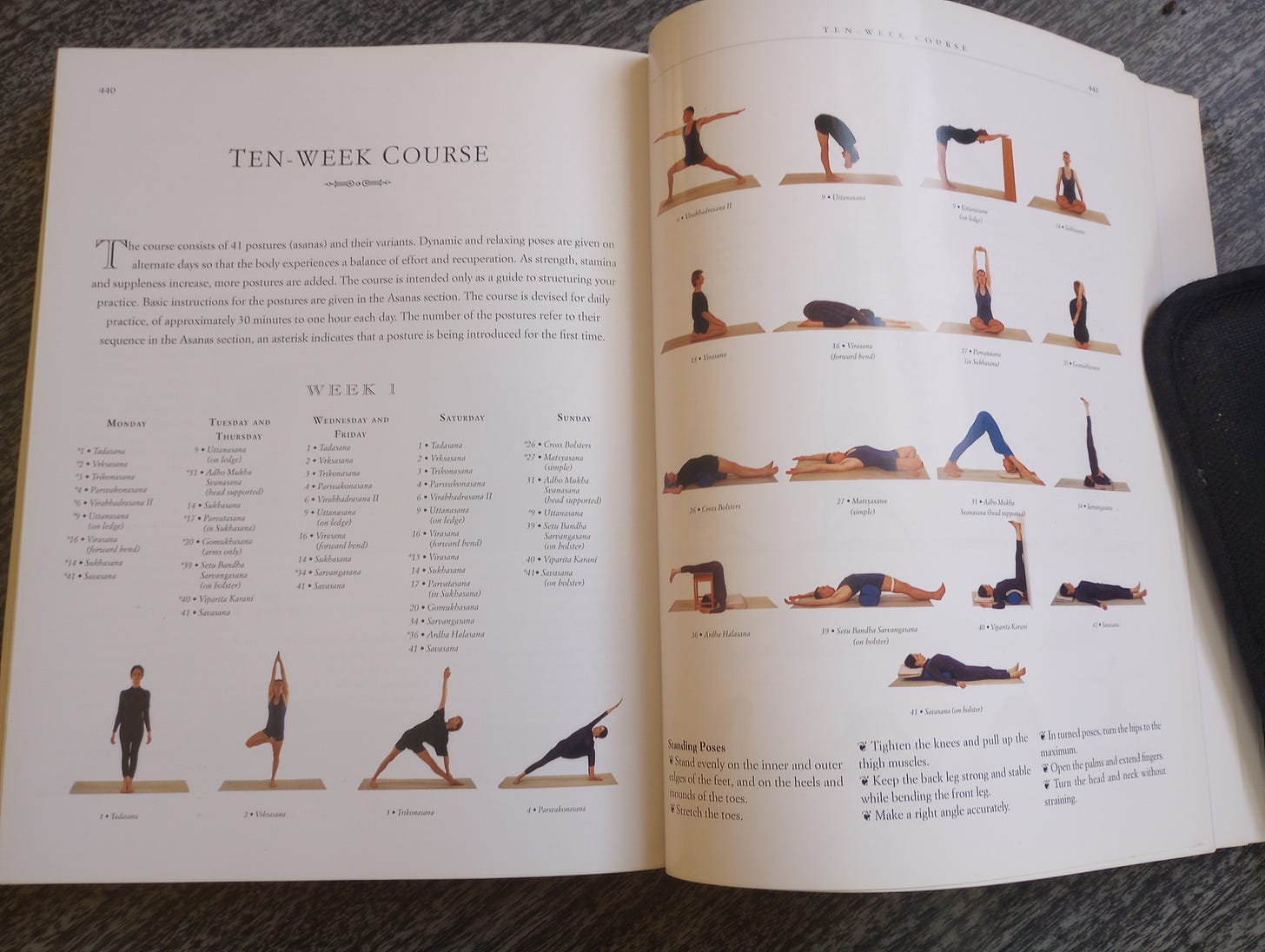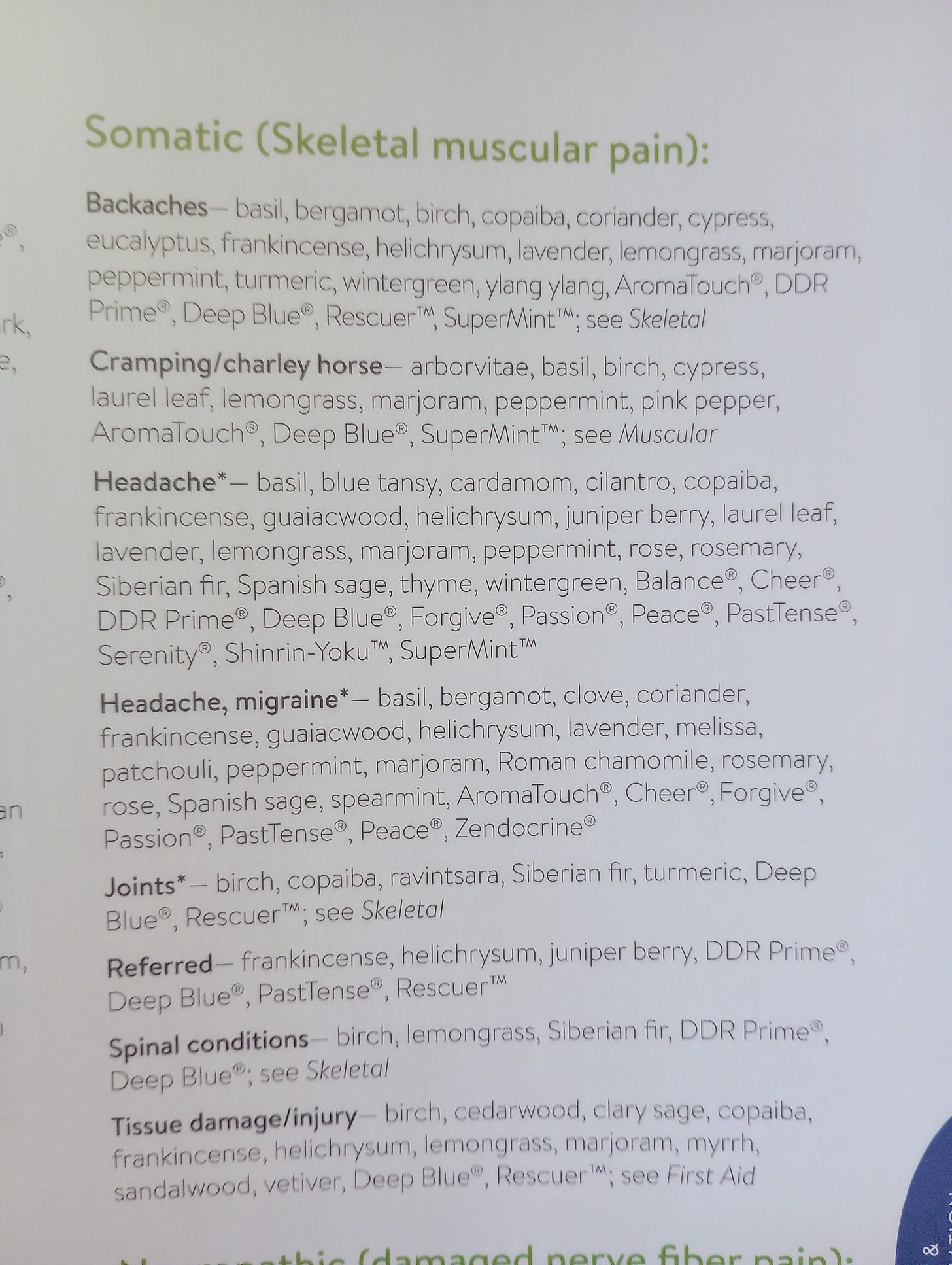Practical Encyclopedia of Home Remedies & Natural Therapies; also Essential oils for pain and inflammation & using your own empty capsules for edible oils.
The Encyclopedia has very useful step by step photos for exercises, yoga, and massage. Essential Oil Book Club.
The Practical Encyclopedia of Home Remedies & Natural Therapies is by Mark Evans, B. Phil., FNIMH, and it includes many topics including medicinal herbs, yoga, massage, meditation, home remedies and natural treatments. (Amazon - available new or there are a lot of used copies online.)

The book opens with chapters or sections on a variety of conditions or systems of the body with strategies for selfcare or other information about risk. These pages include essential oils, herbs, homeopathy and naturopathy recommendations for treating the condition.
The book has lovely color photography and shows how to perform exercises or yoga positions. Massage for self, others, and for baby too is demonstrated in step by step color photography along with a few pages of sensual touch for couples.
Yoga poses spaced out over a ten week course are included in mini photographs with lists for each week’s poses to work on. Positions to use for menstruation discomfort and other common complaints are included. General fitness exercises get a few pages in a later chapter.
Essential oils are mentioned in brief, pages 136-141. Bach Flower Remedies and Homeopathy get one page each. This book is nice as an Encyclopedia provides a little bit about a lot of topics. Then a Chapter on Aromatherapy includes detailed charts and directions for essential oils and has entries for quite a few oils. Massage with essential oils is demonstrated. pages 246-321.
The many step by step exercises and massage techniques are a big value in this book, at a glance. I want to do the ten weeks of yoga poses now that I have seen it.
Trying a few poses reveals that I NEED to. So stiff and sore in my left shoulder - overuse of my right arm maybe and slight scoliosis since childhood. My left side is my weaker side. Use it or lose it. Time to move more and sit less.

The Naturopathy chapter includes diet and nutrition with a helpful one week menu for basic healthy meals with more vegetables and variety than typical. Summary lists are included for nutrients and the most commonly used essential oils.

~~
Tangential thought - is kaempferol found in essential oils or would it only be in water and alcohol extracts? The answer is the later, water or alcohol extracts will contain kaempferol. It is a potent flavonoid like quercetin which can reduce inflammation and fight microbes for us. It can help protect the brain too. KamuKamu berries and tomatoes are a source - KamuKamu are in the tomato family. https://www.sciencedirect.com/topics/medicine-and-dentistry/kaempferol-derivative
Essential oils can add to our lives but the whole foods are great too. A rich tomato sauce made with olive oil and phospholipid rich leafy green herbs would likely be forming more bioactive liposomes that contain water soluble nutrients in the center and fat soluble ones in the liposomal membrane. Beta-carotene would cling to oil in the sauce and kaempferol would be retained in the watery tomato broth as long as gentle heating is happening instead of vigorous boiling.
Essential oils topically and/or internally for Pain and Inflammation
Using some Cedarwood, Eucalyptus, Manuka, or other oils prior to or after a workout can help muscle soreness. Cypress can help stiff joints and Cedarwood may too. Dilute and use topically over the sore areas. There are plenty of others that may help too. See image below with oils or blends that may help Somatic or Skeletal muscular pain.
Backaches (basil, bergamot, birch, copaiba, coriander, cypress, eucalyptus, frankincense, helichrysum, lavender, lemongrass, marjoram, peppermint, turmeric, wintergreen, and ylang ylang.
Muscle cramps or Charley horse (arborvitae, basil, birch, cypress, laurel leaf, lemongrass, marjoram, peppermint, pink pepper).
Headache (basil, blue tansy, cardamom, cilantro, copaiba, frankincense, guaiacwood, helichrysum, juniper berry, laurel leaf, lavender, lemongrass, marjoram, peppermint, rose, rosemary, Siberian fir, Spanish sage, thyme, and wintergreen).
Headache, migraine - basil bergamot, clove, coriander, frankincense, guaiacwood, helichrysum, lavender, melissa, patchouli, peppermint, marjoram, Roman chamomile, rosemary, rose, Spanish sage, spearmint.
Joints - birch, copaiba, ravintsara, Siberian fir, and turmeric.
Referred pain (regional pain related to organ or another area) - frankincense, helichrysum, and Juniper berry.
Spinal conditions - birch, lemongrass, Siberian fir.
Tissue damage / Injury - birch, cedar, clary sage, copaiba, frankincense, helichrysum, lemongrass, marjoram, myrrh, sandalwood, vetiver.
(The Essential Life, 9th Ed., image page 455)

Usage tips - Topical, dilute essential oils in a carrier oil such as almond, grapeseed, coconut, or olive oil. For adults, one drop to five drops of carrier oil should suffice (~ 1/4 teaspoon). For children or more sensitive skin, dilute with one drop to 20 drops of carrier oil (~ 1 teaspoon).
For pain and inflammation, apply to the painful area, frequently until symptoms subside. Every 20-30 minutes at onset, reduce to every 2-6 hours for acute pain, and then 2- 3 times daily for chronic pain. Layering a few different oils can be effective - start with one, and follow up with another after a few minutes.
Internal use can also help pain and inflammation, particularly for chronic pain and internal use may be needed for internal pain. Edible oils can be diluted with a few drops of carrier oil and taken in capsules or water or food. Empty vegetable cellulose capsules are available for sale bulk, and should be pretty inexpensive for lots of them. buying one bottle of empty capsules (as I saw on a MLM company site) would be a REALLY expensive way to buy them.

Example empty capsule product (amazon.com) *I am unaffiliated.

Powdered things could be packaged into capsules all at once, but the essential oils would need to be made into a capsule every day. I don’t think the cellulose capsules will hold the essential oil for very long before it would start oozing out. Fill the empty capsule and take it right away is how I’ve used empty capsules and essential oils. Oregano oil is so strong in flavor that it is generally given in a capsule for medicinal use.
Essential oils in homemade soap
Soap making fans - nice, very thorough video about making your own soap using oils and lye. The example includes lavender and ylang ylang essential oils for fragrance. (Youtube) In the comments we learn that in the Philippines where the flowering tree is wild, ylang ylang is pronounced ee-lang ee-lang.
BEGINNER YLANG YLANG LAVENDER SOAP MAKING LESSON | Essential Oil Cold Process Bar Soap DIY w/ Recipe, Wild Backyard Soaps, (Youtube) *Recipe in the text box below the video.
Math fun - in her 44 ounce batch of soap loaf she used 2 ounces of essential oils, one part ylang ylang (more expensive) to two parts lavender, to cut cost. It made ten bars of soap. She uses a generous amount of essential oil she said because she likes her handmade soap to have a strong aroma - but without anything artificial. A little clay in the soap can help absorb toxins from the skin and the essential oils are good for the skin too.
2 ounces = 60 mL divided by ten bars of soap = 6 mL per bar, slightly more than a small size bottle, ~ 100 drops.
That is a generous amount. The aroma fades when exposed to the air, so it won’t last that long in a bar of soap laying on a counter.
Essential oils mixed in a massage oil that remains closed and in a dark cupboard will last a lot longer. Glass bottles are recommended though instead of plastic. The strong solvent effect of essential oils can break down plastic and may be leading to microplastics dissolved in your oil.
Essential oils represent a lot of plant material.
A four ounce bottle of Lavender essential oil costs $85 (mountainroseherbs.com) and one ounce of Ylang Ylang essential oil costs $30 (mountainroseherbs.com) depending on where you buy it.

Disclaimer: This information is being provided for educational purposes within the guidelines of Fair Use and is not intended to provide individual health guidance.




You can save a lot of money by making your own essential oils from herbs you pick or source. Also save citrus peel and dry it to make essential oil as well. Cheaper and lots of fun!